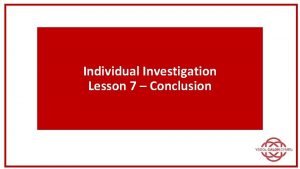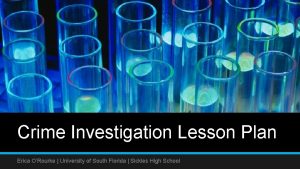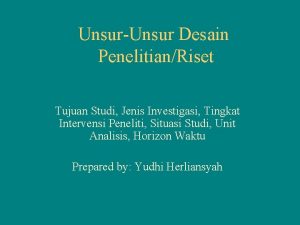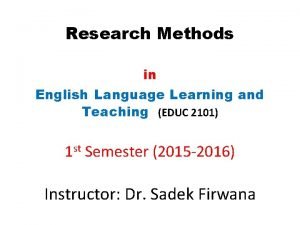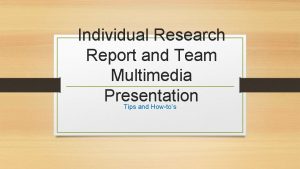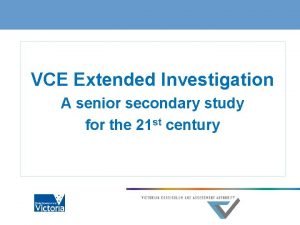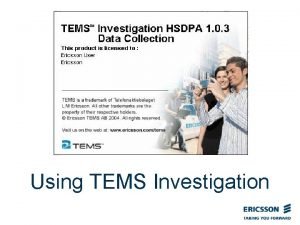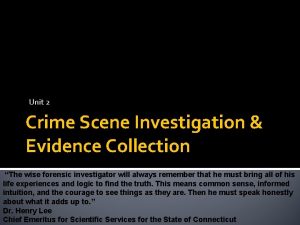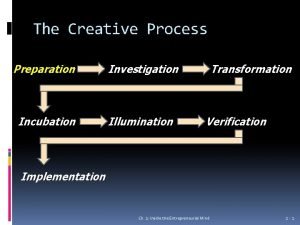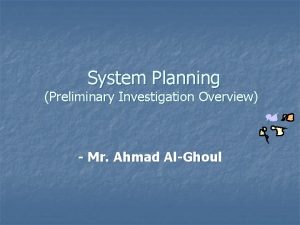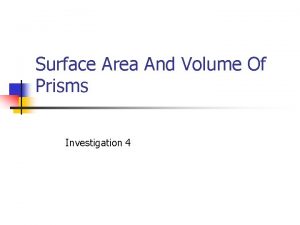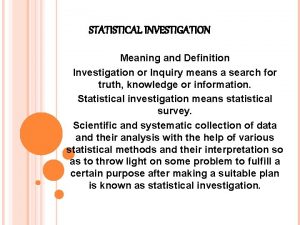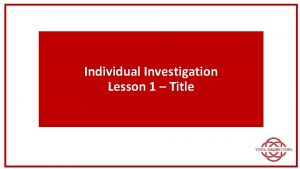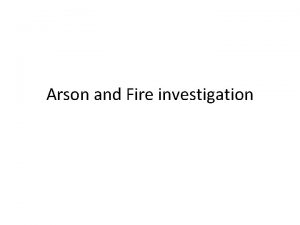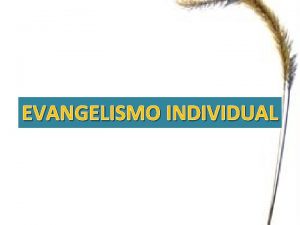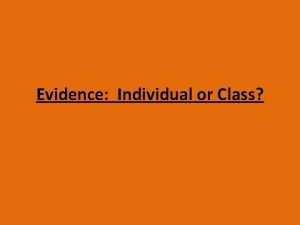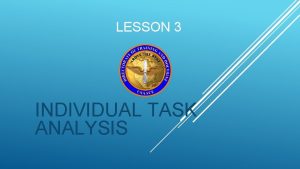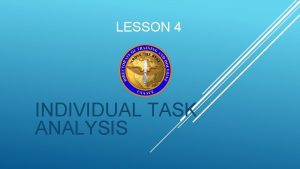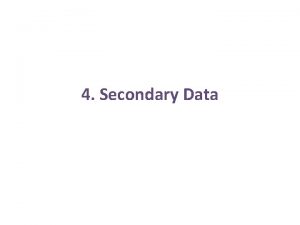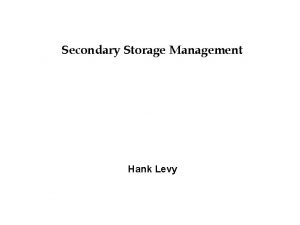Individual Investigation Lesson 5 Secondary Research Secondary Research














- Slides: 14

Individual Investigation Lesson 5 – Secondary Research

Secondary Research This section requires you to demonstrate your digital literacy and research skills, critical thinking skills and problem solving skills. You will be expected to research from a variety of sources the information needed to answer each of your objectives. For the word count this could be 1 -2 sources per objective. You will need to consider Point/ Example/ Explanation when summarising your findings and you need to quote and reference your sources accurately. A guide on how to do this follows along with how to evaluate your sources accurately. It is recommended that you include some reference to quantitative (numerical) data to support your findings to compare your primary (own) research with.

Secondary Research For each objective identify 1 -2 sources What does the research say? Prove it with a quotation correctly referenced POINT EXAMPLE How does this impact your objective and overall investigation? EXPLANATION

Referencing The ability to reference sources effectively is a key to a successful individual Investigation. A failure to acknowledge and reference sources (secondary research) can lead to accusations of plagiarisms. Eg the use of other people’s work and submitting it as your own. Plagiarism is Illegal. This can be easily avoided by referencing your sources. You need to acknowledge when written information from someone else has been used, by providing the audience with the information necessary to find that source. References are used to • • Enable the reader to find the sources you have used Help support your arguments and provide your work with credibility Show the scope and breadth of your research Acknowledge the source of an argument or idea, avoiding a charge of plagiarism

WAGOLL In this example, the student has referenced sources in footnotes at the bottom of the page. However the references could be numbered and then put into the bibliography the end of the investigation

Harvard Referencing Citation When you summarise, refer to or quote an author’s work, you need to acknowledge your sources in the text. You do this by including the author’s name and the date of their work within your text at the point where you discuss their ideas. WAGOLL ‘It has been suggested that medieval tournament resembled in many senses a modern spectator sport, with spectators, chants, national teams, team colours, inflated salaries, transfer fees, celebrity cults and a lifestyle notable for it excesses. ’ (Crouch, 2005) Paraphrasing is rewriting an argument, opinion or point made in a source using your own words. When paraphrasing you must include page numbers. WAGOLL It has been argued ( Harries 2001, p. 21) that the main considerations are the scope of the project, the cost and the duration of the work.

Quotation If you are putting in a direct quotation you must use quotation marks, Italics, and include the page number. If there are more than one authors, only write the first author followed by ‘et al’ which means and others. WAGOLL “At the crux of any discussion of what happened during the sixties, one inevitably comes up against the word revolution” (Green, 1999, P. 17)

Dates and editions – Books To find out when a book was published look at the back of the title page. This page will contain details of the publisher and the publication date. If there is more than one date, use the latest publication date, not the latest reprint date. This is often located next to the © symbol. If no publication date is given put [no date] eg (Thomas [no date]). The back of the title page will also tell you the edition of the book. If the book you are acknowledging is not the first edition, state this in the full reference.

Website Ideally you should aim to include the following information: Authorship, year. Title of web page. [format eg online or email] Publication date. Available at: URL [date accessed] Author and/or organisation Publication Date Title and Format of document Available at (web address) Date accessed Chris Mcgreal, Guardian Online 16 th February 2012 Congress passes payroll tax cut as GOP relents on savings demand. Online http: /www. gua 17 February rdian. co. uk/wo 2012 rld/2012/feb/1 5/us-congresspayroll-tax-cut In your reference list or bibliography the example above would look like this: Chris Mc. Greal. Congress passes payroll tax cut. 16 February 2012. Available at: http: //www. guardian. co. uk/world/2012/feb/15/us-congree-payroll-tax-cut. [Accessed 17 th February 2012]

Social networking sites Twitter, facebook etc are also online sources and should be referenced. Author or organisation Title and format of document online Available at (web address) Publication Date Obama B President Obama comments in favour of tax cuts http: //twitter. c 17. 02. 12 om/#!/baracko bama Date accessed (date you viewed the site) 17. 02. 12 In your reference list or bibliography the example above would look like this: Obama B. 17 February. President Obama comments in favour of tax cuts. Available at: http: //twitter. com/#!/barackobama [accessed 17 February 2012]

Other types Report Conference paper Interview Audio – visual images (TV/Radio) National Health Service (2003) Can walking make you slimmer and healthier? London: National Health Service Peacock, S. ed. 2005. Proceedings of the Ji. SC Conference on the legal aspects of online learning environments. June 1 -2, University of Warwick. London: Routledge. Ahen, B 1999. Interview on Morning Ireland interviewed by…. . John Boyd [radio] RTE Radio 1, 15 February 1999, 0. 30 Dali, S. (1958) Madonna Oil on Canvas [online]. [Accessed 10 July 2009]. Available at: http: //www. oxfordartononline. c om Include the date and location of the conference In the case of TV/Radio programmes, note the date and channel of transmission If there is no individual author use the organisation Beaton, C. , 1956. Marilyn Monroe. [photograph] (Marilyn Monroe’s own private collection) You. Tube. 2009. Bournemouth University Accommodation. Available from: http: //www. youtube. com/watch ? vsidfo [accessed 20 Jan 20] Always state the date the image was included in the source as well as the date it was accessed.

Evaluate the validity and reliability of your sources: The CRAAP Test. You need to demonstrate that you have evaluated the reliability and validity of your sources. You can either comment at the start or end of each source in the research section in the booklet, or you can comment on each source in your bibliography (this is not in your word count, therefore I would suggest using your bibliography if you are running out of words). Use the Key Terms to the left when evaluating your sources. Watch the video link to find out how to evaluate your sources. https: //researchguides. ben. edu/source-evaluation

DON’T FORGET… Things to do as you go along to save time and keep the information you need… 1) Remember to link your research to each objective to stay on track 2) When writing up your research, number each quotation and include the reference in the references section (either a Footnote at the bottom of each page or in a separate References section at the end of the investigation). 3) Any research you look at that is relevant to your research goes into the bibliography at the end of the investigation- even if you didn’t use it or quote from it. 4) Evaluate each source RURU or CRAAP

Deadline Date – Secondary Research Tuesday 2 nd June (Three weeks)
 Conclusion of investigation
Conclusion of investigation Criminal investigation lesson plans
Criminal investigation lesson plans Vcaa chemistry study design
Vcaa chemistry study design Jenis jenis investigasi
Jenis jenis investigasi Qualitative research
Qualitative research Teacher as a researcher
Teacher as a researcher Individual research report
Individual research report Extended investigation critical thinking test
Extended investigation critical thinking test How to use tems investigation
How to use tems investigation What are the seven s of crime scene investigation
What are the seven s of crime scene investigation Transformation in the creative process
Transformation in the creative process System planning and initial investigation
System planning and initial investigation Surface area investigation
Surface area investigation What do you mean by statistical enquiry
What do you mean by statistical enquiry Special right triangle investigation
Special right triangle investigation
